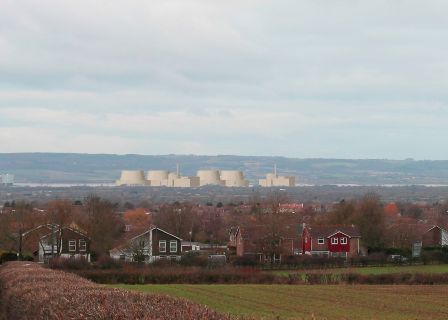Horizon's hybrids for Oldbury
16 September 2010
Horizon Nuclear Power says that it favours the use of hybrid cooling towers at its proposed new nuclear power plant at Oldbury, UK, which are about one-third of the height of conventional natural draught cooling towers.
 |
How a new plant at Oldbury could look with hybrid cooling towers
(Image: Horizon) |
The company - a 50-50 joint venture between RWE nPower and EOn UK - said that it had previously been considering all options on an equal basis. However, Tim Proudler, planning and consents manager for the Oldbury project, said: "Based on the information we have currently available, our preferred option is likely to be a hybrid tower system."
Horizon said that natural draught cooling towers, which can be up to 200 metres in height, "rely on their shape and height to create cooling, whereas so-called hybrid towers use fans and are up to 70 metres in height, more in keeping with the height of the existing Magnox power station reactor building" at Oldbury on the Severn estuary.
Proudler commented: "This has been a big decision for Horizon. Natural draught cooling towers have real advantages. They're cleverly designed to move air without the use of electricity, and could be said to be the obvious technical choice, being cost effective, easy to maintain and sustainable."
He added, "However, we appreciate that these would be a prominent feature in the local landscape. Some of the visual impact could be improved by careful arrangement, but after discussion with, and listening to, the local community, we wanted to respond. In the end, this has to be about achieving an acceptable balance."
In addition to be shorter than natural draught cooling towers, the water vapour plume from hybrid towers is also typically less visible, Horizon noted. All the UK's current nuclear power plants are cooled by seawater, making cooling towers something of a new thing for nuclear in the country and a hot topic in the Oldbury area.
At a public meeting in March, Derick Cottell, site development manager for Horizon, said: "It is not possible to have a direct cooling system for a new station at Oldbury because the site's electrical capacity is eight times the size of the existing station and will produce eight times the heat." He added, "If we were to put that heat into the estuary that would be unacceptable ecologically."
Horizon plans to submit a planning application for the new plant at Oldbury around 2014. According to the company, "Given the right market conditions, and subject to a final investment decision, preliminary works could begin in 2016, followed by main construction from 2019."
Horizon is yet to decide which of the two available reactor designs it would like to build. Both the Areva EPR and Westinghouse AP1000 are engaged in the Generic Design Assessment process, due to certify them for build in June 2011.
Horizon has said that the new Oldbury plant would need either three or four cooling towers, depending on the type of reactor chosen.
Researched and written
by World Nuclear News